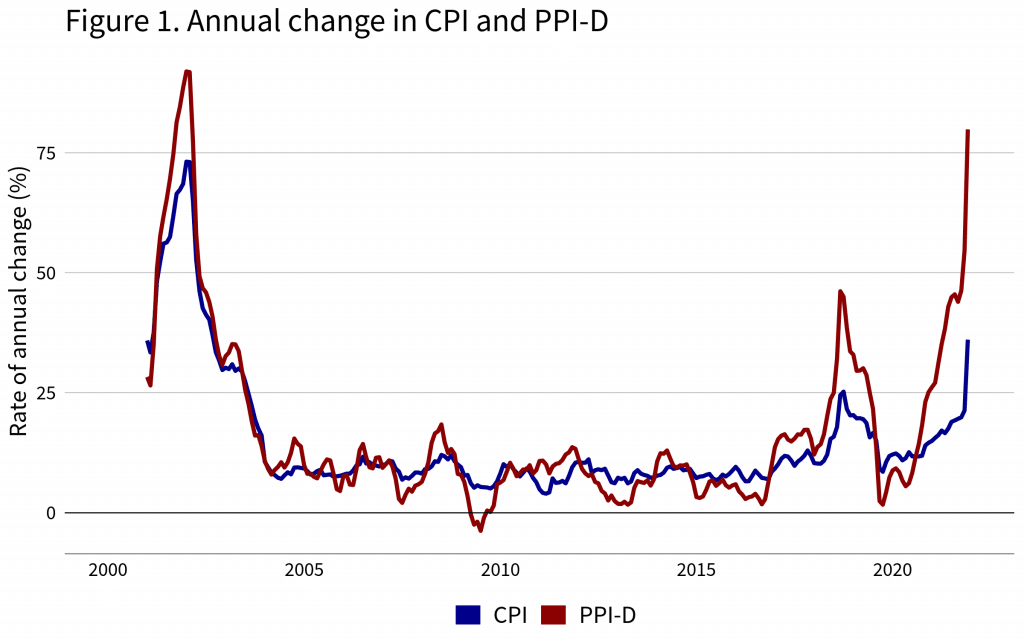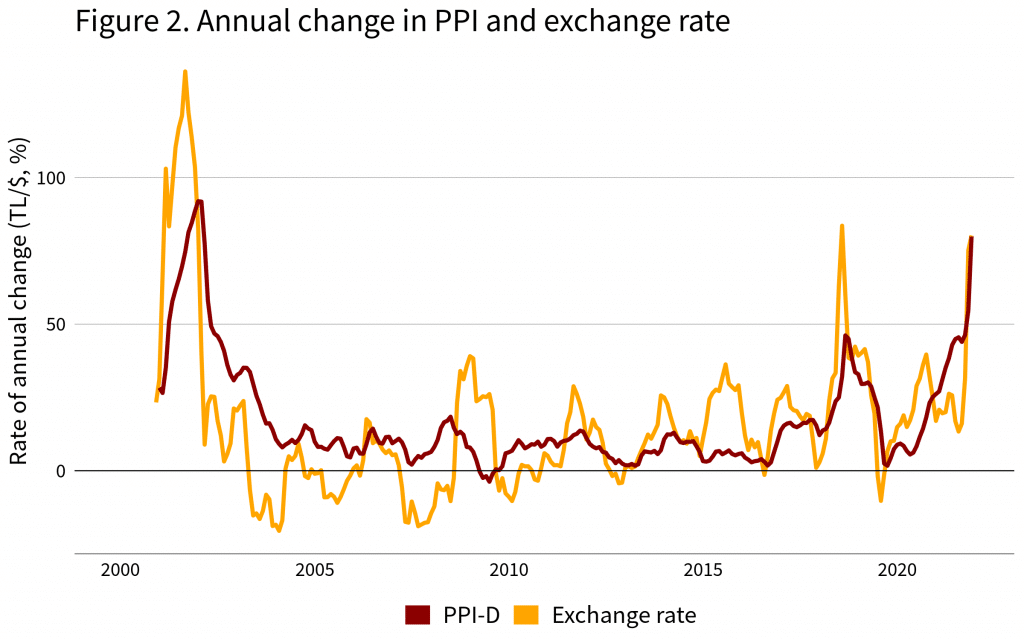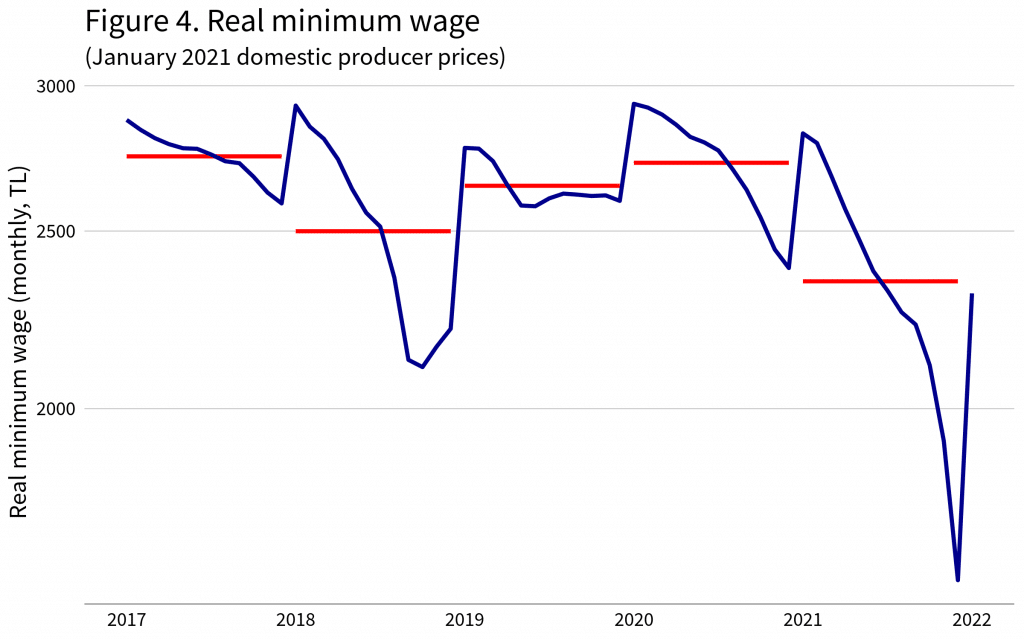

Turkey is going through unprecedented days. At the beginning of December, while the exchange rate increased without any apparent barrier, the government raised the minimum wage by 50 percent. According to the Turkish Statistical Institute (TÜİK), the annual increase in the consumer price index (CPI) was only 21 percent, and opposition parties were demanding an excessive rise of 40-45% in the minimum wage. Wage-earners would be protected from inflation.
But the December data announced on January 3 changed the situation. According to TÜİK, in December 2021 only, the CPI has increased by 13.6 percent, and the inflation rate for 2021 reached 36 percent. The rise in the domestic producer price index was 80 percent, more than twice the CPI. Other products will follow the enormous natural gas and electricity price hikes announced on the last day of 2021 to be put in effect as of the first day of 2022. Despite these increases in prices, the government announced on January 3 that salaries and pensions of the civil servants will be increased 30 percent in the first half of 2022. Given the excessive increases in prices, what could happen to real wages in the coming year?
CPI-PPI gap
Before answering this question, it is better to look at the concepts of price indices, as the accuracy of the price data and the widening of the CPI-PPI gap have become a matter of debate in recent years.
CPI is the average price of products consumed by consumers in a country. The price data used in the CPI calculation are the prices paid by the consumer (including taxes on products). The change in the CPI index is calculated as the weighted sum of changes in consumer prices where weights are equal to shares in the consumption bundle. The consumed products include manufactured goods and services such as transportation, housing (rent), education, and health.
The domestic producer price index (PPI-D, PPI hereafter) is calculated from the prices of the products produced and sold in Turkey. The producer price is the price received by the manufacturer (excluding the value-added tax, transportation costs, etc.). The products covered by the CPI and PPI, their weights, and the price definitions show significant differences. For example, while iron and steel products contribute significantly to PPI, they do not contribute to CPI.
Despite these differences, it is expected that the CPI and PPI will not differ significantly from each other in the long run; that is, the gap between the two variables will not widen too much. For example, the increase in iron and steel prices does not directly contribute to the CPI but, due to the rise in iron and steel prices, the prices of products such as automobiles and durable consumer goods would increase over time.
After this short explanation, let us look at how CPI and PPI have changed in Turkey in the last 21 years. As seen in Figure 1, the inflation rate seems to approach the 2001 crisis levels again after 20 years.

CPI-PPI changes in Turkey in the last 20 years
There are three periods in which the gap between PPI and CPI widens: the 2001 crisis, the 2018 Pastor Bronson crisis, and the 2021 currency crisis, which we experienced most clearly last month.
Figure 2 shows a close relationship between the widening of the PPI-CPI gap and the rise in the exchange rate in all three periods. The increase in the exchange rate causes the PPI-CPI gap to widen because imported inputs are used for manufacturing industrial products (more than the service sectors) that make up the PPI, which leads to a rise in prices through cost effects. We should also emphasize that the increase in the exchange rate was less significant in the 2021 crisis; its full impact has not been experienced yet.
The increase in raw material and energy prices worldwide and credit expansion in Turkey is also causing an increase in PPI. For this reason, the increase in the PPI (even if the rise in the exchange rate can be stopped) may remain at a high level soon, which will harm the CPI.

What happens to wages when inflation rises?
A significant part of wage-earners in Turkey work on the minimum wage, and other wages follow closely. The minimum wage (since 2016) is set once a year, at the beginning of the year. As the prices tend to increase almost daily, the actual minimum wage is constantly shrinking throughout the year.
CPI is generally used to calculate the real wage. Figure 3 shows monthly actual minimum wage data for 2017-2021.[1] The red horizontal lines are the average real wage for the relevant year. January 2021 prices are used in actual wage calculations.
The figure shows that even if the minimum wage increases more than the inflation rate of the last year, it may decrease in actual terms. For example, the annual increase in the CPI was 12% at the end of 2017. In January 2018, the minimum wage was increased by 14.2%. Despite this increase, as shown in Figure 3, the average minimum wage in 2018, was lower than the minimum wage in 2017 because the CPI increased faster in 2018.

What will happen to the actual minimum wage in 2022?
It depends on when and how much prices will rise in 2022. For example, if the CPI increases by 3.2 percent each month, the CPI will have increased by 50 percent at the end of the year, and there will be no change in the annual average real wage. However, if the CPI increases by 15 percent, 10 percent, 8.5 percent in the first three months, and 1 percent in the remaining nine months, the total increase will still be 50% at the end of the year, but the average real wage for 2022 will decrease by 12 percent compared to 2021.
Unless there is a sharp decline in the exchange rate and raw material prices, prices will continue to rise rapidly in the first months of 2022, as a result of which the real minimum wage will rapidly erode. The price hikes at the beginning of the year also heralded this process. For example, the increase in only electricity and natural gas prices at the beginning of the year will directly lead to a 1.8 percent increase in the CPI. Sectors using electricity and natural gas as inputs will also increase their own prices shortly, therefore will raise the rate of inflation further. In addition, credit expansion pushed to achieve high economic growth, and increased public expenditures may also cause inflationary pressures. As a result, we are back to the 2000s in terms of inflationary dynamics.
CPI-PPI in real minimum wage
Here we have used the CPI to calculate the real minimum wage, but the PPI can also be used to calculate the real wage both as a “leading” indicator of the CPI and to measure the “cost of labor” to the employers (“real product wage”).[2]
Figure 4 shows the monthly real minimum wage based on PPI (January 2021 PPI = 1). The PPI-based real minimum wage presents a strikingly negative picture for wage earners. According to the data:
• the average annual actual minimum has not reached the level of 2017 in the last four years,
• the real minimum wage fell sharply in 2021, and
• despite the 50% nominal increase, the actual minimum wage in January 2022 remained below the 2021 average. With possible losses during the year, the real wage rate of 2022 is likely to be well below the real wage of 2021.

Which prices should be used to calculate the real wages of wage earners? If we think that the prices are close to the CPI, we are faced with reality close to Figure 3. Or, if we think they are closer to the PPI, use Figure 4. In both cases, it is possible to say that the increase in prices will remain high in the coming months, and real wages will erode rapidly.
Someone must pay the price of inflation. Those who pay the price are almost always the poorest segments of society, because wages are fixed for a year yet prices go up almost daily. If the wage-earners must be protected against inflation, it is necessary not to cause inflation first.
Notes
[1] In Figures 3 and 4, it is assumed that the CPI and PPI increase 5% in January 2022.[2] The real wage based on PPI shows how much the labor cost has increased for firms relative to their own prices. According to Figure 4, the real labor cost has decreased since 2017. The absence of income tax from the minimum wage in 2022 will further contribute to this trend.


